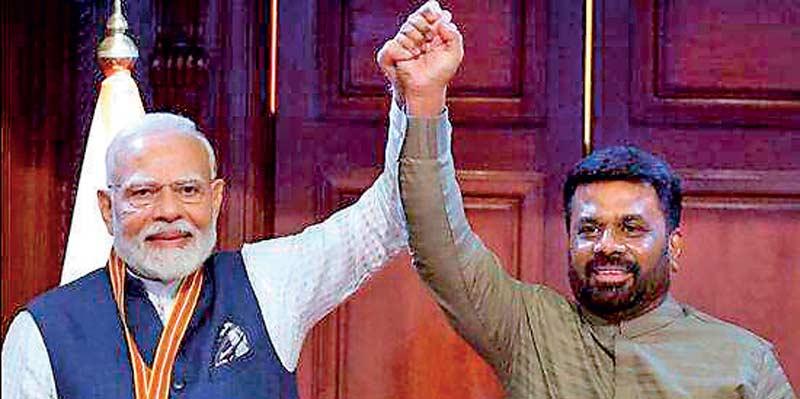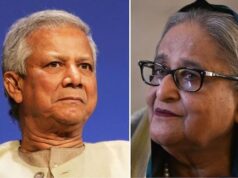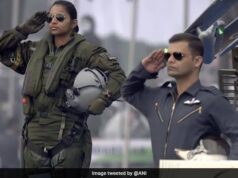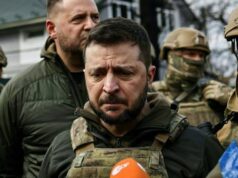How the JVP shed ‘Indian expansionism’ 53 years ago?

During Indian PM Narendra Modi’s visit to Sri Lanka President Dissanayake conferred him with ‘Mithra Vibhushana’, the country’s highest civilian honour.
It is strange that the political analysts – both so-called and serious – have pathetically failed to note that the Janatha Vimukthi Peramuna (JVP) had dropped the concept of “Indian Expansionism” some fifty years ago in 1972.
Hence, they find a contradiction in current NPP government’s relationship with India. The issue had surfaced again with Indian Prime Minister Narendra Modi’s three-day visit to Sri Lanka this month during which time seven MOU’s including one on defence corporation between the two countries were inked.
Many “analysts” were seen waxing eloquent on JVP’s “U-turn” from Indian expansionism to conferring Modi with ‘Sri Lanka Mitra Vibhushana’ the country’s highest civilian honour by President Anura Kumara Dissanayake who is also the leader of the JVP.
The honour was awarded to Modi on April 5, a day extremely important for the JVP as it was on April 5, 1971 that the party formally launched its first bloody insurrection.
Prior to this insurrection the JVP conducted five discussions or ‘classes,” as they described them, with their new recruits the third of which had been titled “Indian Expansionism.”
Other four classes were Crisis of Capitalist Economy, Independence: A Neocolonial Ploy, Leftist Movement in Ceylon and the Path the Lankan Revolution has to take.
The Indian expansionism is not JVP’s own child. It was a concept created by the Chinese leaders and accepted by their supporters around the world, especially those in South Asia.
The idea was based on some of the points presented by Jawaharlal Nehru in his ‘Discovery of India’ written during his incarceration between 1942 and 1945.
JVP as an offshoot of the Peking Wing of the Communist Party led by veteran trade unionist Nagalingam Shanmugathasan who was at the forefront in selling the idea.
However, as the party was criticized for being anti-Tamil when conducting this “class” and as India aligned more and more to the then Soviet bloc, the JVP leaders dropped it from their educational programme in 1972, while revising all five classes, during their incarceration, subsequent to the failed first insurrection.
Accordingly, the new classes were named as
1. Economic Crisis,
2. The Menshevik Movement (a name-change of the formerly “Leftist Movement”),
3. The role of Sri Lankan revolution (a highly theoretical lecture departing the party’s formerly Maoist standpoint),
4. The path to socialism (similar to the formerly “Path the Revolution has to take”) and
5. Building the Bolshevik party (A plan to build a structured and disciplined political party).
Never in their history spanning over half a century since 1972, did the JVP carry forward the concept of Indian expansionism. Only the critics of the party have been burdening themselves to carry it along with them to occasionally embarrass the former rebels.
There have even been occasions when the JVP had come forward to defend India as a friend of Socialist camp. The JVP along with two other leftist parties was unfairly proscribed by the United National Party (UNP) government headed by President Jayewardene in 1983, falsely accusing that the JVP was behind the anti-Tamil pogrom in the same year.
The government, at the same time, strengthened relationships with the West and Israel, provoking pro-Soviet India.
JVP leader Rohana Wijeweera who had gone underground then circulated a handwritten article in the form of an interview in 1984 defending India amidst the geo-political situation of the day.
He argued that the pro-Western policy of the Jayewardene government had culminated in the encirclement of India by three countries sided with the West, since Pakistan and Bangladesh were already in the anti-Soviet camp. He also warned of India’s wrath in the light of the government’s foreign policy.
He was proven right. The very riots against Tamils in 1983 that was used by the Jayewardene government to proscribe the JVP gave India a leverage to tame the Jayewardene government.
India’s pressure first came in the form of soft diplomacy where Indian leaders pushed Jayewardene since 1984 to devolve political powers to the Tamil dominated areas of the island.
Indian authorities also provided arms, funds and training behind the scenes to the Sri Lankan Tamil armed groups Later India’s pressure took a violent turn when the Indian navy and the air force violated Sri Lanka’s territorial waters and the airspace in 1987, in the guise of supplying food to the Tamil people entrapped in the Jaffna town due to operations by the Sri Lankan army.
Sri Lanka succumbed to the pressure and signed the Indo-Lanka Accord safeguarding Indian interests in the region, in the same year.
Despite Wijeweera’s warning thus coming true, his party protested Indian intervention in Sri Lanka’s internal affairs tooth and nail.
In fact, JVP by that time had taken to arms as its four-year long peaceful campaign to win over its right to democratic politics which it had lost with its proscription, had failed. That was JVP’s second insurrection.
Nevertheless, JVP and India seems to have come to an understanding at the tail end of that insurrection. Somawansa Amarasinghe had taken over the reins of the party after the custodial killing of Wijeweera by the army in 1989 and escaped to London.
Later, Amarasinghe thanked former Indian Prime Minister V.P. Singh during his first public meeting in Kalutara after his return in 2001, for facilitating his escape from Sri Lanka.
History indicates that the JVP’s relationship with India had ups and downs throughout and each turn had followed a specific objective situation.
Also, JVP’s policy pendulum had started to swing during Wijeweera’s time itself. Anura Kumara has just been continuing that legacy. Policy pendulum towards India is not a monopoly of the JVP.
It was the SLFP led by Sirimavo Bandaranaike that had the highest show of protest to the Indo-Lanka Accord in Colombo on July 29, 1987.
Later her party controlled all provincial councils created under the Indo-Lanka Accord, in Sinhalese dominated areas.
Similarly, Gamini Dissanayake, a senior minister of the Jayewardene government had organized a massive demonstration against Indian intervention in Sri Lanka on June 4, 1987, the day Indian air force forcibly airdropped food parcels over Jaffna town.
Two months later he was in the forefront in welcoming Prime Minister Rajiv Gandhi who visited the island to sign the Indo-Lanka Accord. There have been so many similar somersaults by various parties and politicians including Ranasinghe Premadasa with regard to India.
However, none of them would justify the current NPP government’s failure to publicize the MOUs it signed with India.
It is ludicrous on the part of Foreign Minister Vijitha Herath to inform the people to gain access to them through RTI applications.
Transparency in governance is not something that people have to beg for.
Source:Daily News




